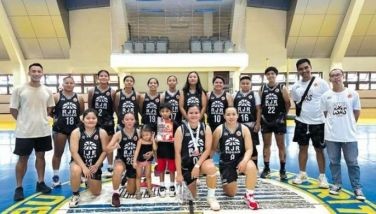UAAP as model
I’ve always been a believer of using benchmarks as a resource tool if one wants to become better. It’s not a case of admiring for the sake of admiring, but an honest to goodness case study for all to learn from. In the world of sports, the University Athletic Association of the Philippines, better known as UAAP, is a model that stands out. Some even say that it outshines the PBA and other commercial leagues as an example of how get things done in the sports business.
The UAAP kicked off its 2011 season yesterday with an Olympics-style opening ceremony at the Marikina Sports Complex. Departing from the usual opening ceremony that used to be exclusively for basketball, yesterday’s event gathered some 3,700 athletes in 15 sports from the UAAP schools. The new approach for the opening was only proper as it proudly declares how big the league has become through the years. With this opening also came an eight-page supplement in the Philippine Star, The FREEMAN’s mother unit, complete with a team-by-team forecast, a schedule and feature stories. But while the supplement is a mere spread of a newspaper, it also shows to all how far ahead the UAAP has reached as compared to all other leagues in the land: pro, commercial or collegiate. All others are so far behind it’ll take a miracle to get them to be at par with the UAAP.
But how did the UAAP get to where it is today? It’s actually a combination of several key success factors that when put together, produced a gem of a product that has been admired by its legions of fans. The UAAP’s primary product is still its basketball game. While its basketball play (per se) may be inferior to that of the pros or commercial leagues from a technical view, its venues are filled and TV ratings are higher. The UAAP brand of basketball has proven that there’s more than just basketball to the games. It’s a unique basketball experience that can’t be matched by any other league in the country. The intense rivalries and balanced competition has brought about exciting games. With the exciting games come the throngs school-based fans of who are stubbornly loyal and committed. These range from grade schoolers to lolo’s and lola’s. A glimpse of the crowd on TV always illustrates this wide range of the ages that can’t be found in other leagues.
Another key factor that has worked is the way the UAAP has been built as a brand. With the right key ingredients of a good marketing campaign in place, the UAAP has been promoted very well to its audience. The entry of broadcast giant ABS-CBN was the start of better things to come for the league. With its nationwide reach and creative ways to sell a product, ABS-CBN projected the UAAP to “star” status in the same way that it launched all its showbiz superstars. The UAAP can actually claim to be a “Kapamilya” if only it could speak as one person. It’s now a regular thrice a week show on TV and can match up against any other sports program for TV ratings. With TV ratings/audience automatically comes the “good news” for the league: revenues. The UAAP basketball production is the biggest drawer of advertisers in the local world of sports as a collective season. My guess is that only a Manny Pacquiao fight can outdo the UAAP in terms of advertising revenues. But Pacquiao fights only two to three times a year. The UAAP games are on TV three times a week from July to October. Have you seen the UAAP’s TV advertisers? The biggest TV ad spenders are there: from beauty care products to telecom, fast food, pharmaceuticals and more. With many advertisers wanting to come in, TV ad spots can now push for very high but acceptable rates. And the advertisers don’t mind it since they know they’re getting their money’s worth. If a product’s target market is close to that of the UAAP, you can bet that you’ll see their ads on UAAP games starting tomorrow.
Isn’t it strange that I haven’t even written about UAAP’s teams, players and basketball tournament? But that’s the point. The UAAP is no longer only about basketball. It’s become so much bigger.
As the UAAP season begins, we too, have to do our own homework. We do have the CESAFI here and I’m sure that we don’t want to be left behind. If our CESAFI schools can work together to work for a long term vision, I’m sure we can work something out. While it may be impossible to match the UAAP, we can at least start working towards making the CESAFI bigger and more attractive as the years roll along. The UAAP is already so popular, yet continues to innovate to become a better league. Can the CESAFI do the same?
***
Time-out: Thanks to the runners who joined the Animo La Salle Run today. You all contributed to the scholarship fund drive of the De La Salle ASMC Alumni Association. >>> You can reach me at [email protected].
- Latest
- Trending























